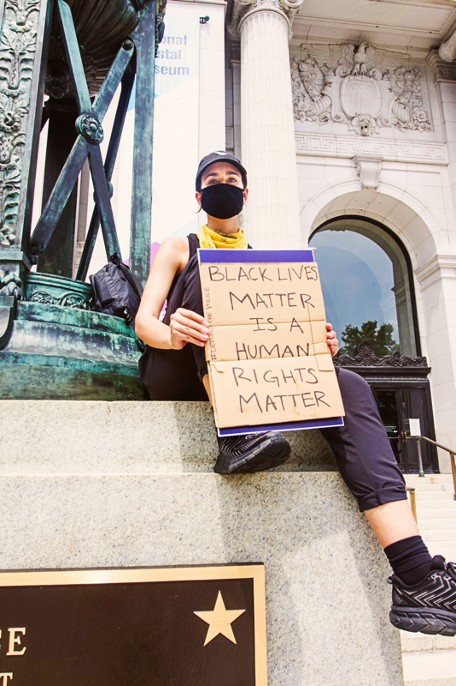
In the past few weeks, the senseless killings of Black Americans like George Floyd, Breonna Taylor and Ahmaud Arbery by police officers have horrified millions of Americans, with many taking to the streets to protest as a means of political activism.
As the country marches on to make its demands known—defund the police, arrest the killers responsible and spread Black Lives Matter messaging— one key population is noticeable on the streets: the youth.
History has shown how influential teenagers and young adults have been in politics: If you look at youth activists from any era, it’s clear that protests would have been less effective without their organizing, vocal support and strength in numbers. From college students of the Student Nonviolent Coordinating Committee (SNCC) during the 1960’s Civil Rights Movement, to Marjory Stoneman Douglas High School students who started the March for Our Lives campaign just two years ago, the importance of youth engagement continues as the nation now marches for the end of police brutality and racism.
On Saturday, June 6, more than 10,000 people took to the streets of Washington D.C, becoming the largest protest yet in the country’s capital. The march began on Capitol Hill with thousands walking towards the White House and breaking off into several smaller protests at the recently re-named Black Lives Matter Plaza, a street where D.C. Mayor Muriel Bowser had commissioned local artists to spray paint “Black Lives Matter” in big yellow letters on the pavement.
Scores of students and young adults thronged the protests, and we talked to those who had a lot to say about why they were protesting and the importance of youth activism today:

Taylor, 25 years old
A local resident of Washington D.C, Taylor first started protesting four years ago while she was still a college student in Georgia following Donald Trump’s election as President of the United States.
She says, “As a white person, I realize that it’s not enough to just be a good white person or a non-racist. It takes some action too.”
She’s been to several protests this month for racial injustice in the city and has also spent time donating to relief funds and educating white friends and family about how “all lives can’t matter until Black lives matter.”
She sees the youth as a powerful tool for change during this time, explaining that young adults are the ones who are the best versed on social media platforms, and that so much of activism is digital. She hopes that the momentum of education and action these protests have brought doesn’t stop with the protesting, and that the country continues to advocate for the end of systemic racism.

Aaron, 21 years old
University of California, Berkeley student Aaron is quarantining at home in nearby Alexandria, Virginia, since COVID-19 forced him to leave college early.
To Aaron, racism lives at an intersection of multiple different forms of oppression. He believes that through the Black Lives Matter movement, “We can effect the change that’s been so desperately needed in our society.”
As a veteran protestor, Aaron partially attributes social isolation to why more people have joined protests in recent weeks and why there is a greater sense of outrage: “We’ve all been stuck in our house for months, feeling the effects of systemic injustice.”
He’s a firm believer that politics and protests work hand in hand, and hopes these protests will eventually abolish the police so that resources can be diverted to other areas that need attention, like mental health care services, building homes, and more.
To other youth activists, he urges continued pressure on the system: “Whatever you do, don’t take your foot off the gas pedal.”

(Image courtesy of Sarah A. Murray)
Ayana (14 years) , Aya (15 years), Karli (12 years) and Drew (14 years old)
Siblings Aya and Ayana from Washington D.C., with friends Drew and Karli, all attended the protest since racism directly affects them and because they wanted to represent their generation.
“We are tired of being discriminated against, so we are here because the movement will make a change,” says Ayana.
Her brother Aya pipes in to say he wants to help bring about the end of systemic racism in the country, especially the police’s behavior towards Black people: “The youth need to be involved. We need to know what’s going on.”
Karli also explains that even though all lives matter, Black lives are top of mind because, “right now we are the ones being killed. We matter too; we’re important too.”

Diana, 23 years old
A student of George Mason University but originally from Colombia, proud Latina Diana says that to her, Black Lives Matter means abolishing the brutality that stems from systemic racism around the world:
“It is a unifying movement, one that also affects other minorities.”
She has been to other protests before, but this D.C protest was her first time marching. For Diana, protesting is important because it’s a part of her constitutional rights.
“We have a right to stand up for things we believe in and a right to protest to make our country and world a better place.”
She explains that part of making the world a better place is by “showing up in numbers and showing that we stand in solidarity—right now with Black people—and that we are not going anywhere.”
She’s hopeful the protests lead to two outcomes: on a broader level, that racism will be eradicated, and on a narrower level, that the police will be defunded. Diana thinks that the United States doesn’t need militarized police to help with communities—instead, the money should be reallocated to improving the welfare of lower income communities.
“The money needs to be going to the education systems,” she concludes.





